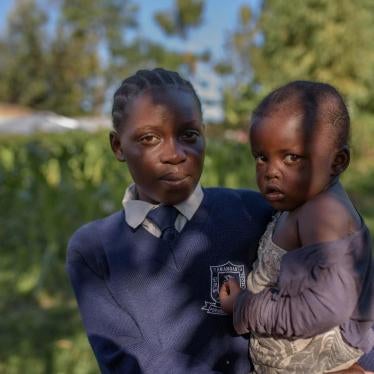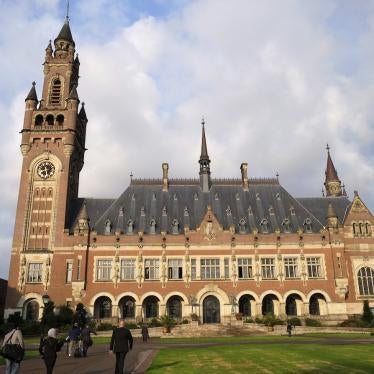(Beirut) – Iraqi authorities should order an immediate, transparent, and independent investigation into lethal police and army shootings of anti-government protesters on March 8, 2013, and others in recent weeks. The authorities should also ensure that those responsible for unlawful killings or excessive force are brought to justice.
Police may have killed one person and wounded others when they fired on protesters in Mosul on March 8, 2013. Soldiers who opened fire on demonstrators in Fallujah on January 25 killed nine people. Human Rights Watch on March 9 interviewed witnesses to the Mosul shootings, who said soldiers also searched and harassed demonstrators as they approached the protest site and tried to prevent ambulances from carrying away wounded people.
“Iraqi authorities need to intervene before further lives are lost,” said Joe Stork, deputy Middle East director at Human Rights Watch. “Security forces are repeatedly opening fire on protesters. The government needs to find out why and hold anyone responsible for excessive use of force to account.”
The March 8 protest in Mosul was one of the ongoing regular demonstrations that have gripped Iraq’s predominantly Sunni provinces since December 2012, when government security forces arrested 10 bodyguards of Finance Minister Rafi al-Essawi, a Sunni. The demonstrations, called to protest what the Sunni demonstrators say is their unfair treatment by the government and the imprisonment of Sunnis on little or no evidence, were initially largely without incident . On January 25, however, soldiers fired at protesters in Fallujah after they threw rocks at soldiers, killing nine. Since then, soldiers and police have fired on several demonstrations, including the one in Mosul on March 8. One protester, Mahmoud Saleh Yassin, died and nine others were wounded.
Witnesses to the Mosul shootings told Human Rights Watch that federal police officers opened fire with live ammunition after protesters began throwing stones at them. It is unclear whether the police gave any warning before opening fire. This contrasts with the version of events provided by the Interior Ministry later that day, which accused “infiltrators” among the protesters with Kalashnikov rifles of starting the shooting and provoking the use of live fire by the federal police. The ministry said it had appointed an investigative committee to look into the matter further but was silent as to whether police fire had killed Yassin.
General Mehdi al-Gharawy, head of the 3rd Division of the federal police, whose officers opened fire in Mosul, gave yet another account in a video uploaded to YouTube. In the video he discusses the shooting but makes no reference to “infiltrators,” suggesting instead that demonstrators had “tried to burn the riot police car or get control of it” and that riot police were “the first security forces who had contact with the demonstrators.” He also claims that Yassin had not been killed in Mosul’s Ahrar Square, where the shooting took place. “Believe me, if the dead body was inside the square, everybody would be able to show it in the media,” he said. “This body came from outside the square.”
The police chief’s claims echo assertions that Deputy Prime Minister Hussain al-Shahristani made in January, following the killings of protesters by the army at Fallujah, when he accused demonstrators of bringing the bodies of two insurgents killed at a checkpoint to add to those of the protesters shot dead by the army.
Three witnesses to the Mosul shootings interviewed by Human Rights Watch all said they had seen no firing from among the protesters though they agreed that protestors had thrown stones in the direction of the police. They said that soldiers insulted and verbally provoked the demonstrators as they approached Ahrar Square, while 150 to 200 police stationed at what protesters refer to as the square’s “new gate,” which gives access to the square, searched those passing through and threatened them with arrest.
The witnesses said the police pressed forward when some demonstrators began throwing stones at them, then began firing. The witnesses did not see Yassin hit, but one of the witnesses was in the square when Yassin was shot in both legs. The witnesses said the police initially tried to prevent ambulances from entering the square so the wounded had to be carried out to them.
“Given the seriousness of these events and the differing official and other accounts, it is especially important for the government to set up a thorough independent inquiry to find out exactly what happened and who is responsible for the death and injuries,” Stork said. “An Interior Ministry investigation is not independent as it will appoint and report to the same people who were ultimately in charge of the police involved.”
A parliamentary committee was appointed to investigate after the January 25 killings by the army in Fallujah, but it has yet to disclose its findings.
Under international law, security forces engaged in policing operations are permitted to use lethal force only in exceptional circumstances, when it is strictly necessary to protect their own lives or the lives of others. Even then, according to the UN Basic Principles on the Use of Force and Firearms by Law Enforcement Officials, the primary international standard, security forces are required to use force and firearms only as a last resort, after less violent means have failed, and to exercise restraint to minimize damage, injury and loss of life.
The UN Principles oblige governments to treat arbitrary or abusive use of force and firearms by law enforcement officials – including soldiers when engaged in policing operations – as crimes punishable under the law.
“The Iraqi government should ensure that its police and other security forces engaged in policing and crowd control understand how they should respond and are trained for these operations so they can follow the standards set down in international law,” Stork said. “They should be defusing tensions at demonstrations and protests, using the least force necessary, not pouring fuel on the flames by rushing to use lethal or other excessive force.”
Accounts of Increasingly Violent Government Response at Mosul Protests
Media reports and witnesses who spoke to Human Rights Watch said that soldiers or police have opened fire on demonstrators in Mosul’s Ahrar Square on at least four separate occasions in January and February, and have attacked journalists from Sharqiya and Sama Mosul television stations. During an attempt to disperse protesters in Ahrar Square on January 7, army vehicles ran over several people, injuring four, which resulted in police replacing the army as the security forces assigned to protests in Mosul.
Witnesses to the March 8 protest in Mosul told Human Rights Watch that soldiers regularly harass people attending the protests. People who attended the protest said policemen from the Federal Police’s 3rd Brigade take photographs of the demonstrators to intimidate them, block roads to the demonstrations and frequently threaten to arrest people. The witnesses said that federal police in Mosul regularly shout insults at protesters as they walk by, calling them “terrorists” and “brother of a whore,” or saying “Mosul people, you have no dignity.” One witness said that police refuse to allow food or medicine into the square and that they sometimes single out women or older men to hit them in the presence of other demonstrators.
Witnesses also told Human Rights Watch that police arrested people at two Mosul-area hospitals after the demonstrations. One man who was injured in the March 8 protest told Human Rights Watch that he left the hospital where he was treated for a bullet wound to his leg because he was warned by others that “they were arresting people from the hospital.”
Two witnesses told Human Rights Watch that they had spoken to wounded demonstrators after the protests who saw ambulance drivers forced to get out of their ambulances while they were attempting to transport the wounded to hospitals, and that police then confiscated the ambulances. These witnesses also said that drivers told them that police sometimes beat the drivers as they were transporting the wounded.
Witnesses also told Human Rights Watch that Federal Police arrested a protest organizer, Sheikh Hussein Obeid al-Jabouri, on the morning of the demonstrations, as he was walking into Ahrar square, the site of ongoing demonstrations. A person who frequently attends the demonstrations in Mosul told Human Rights Watch that federal police also arrested three of al-Jabouri’s sons later that day. Human Rights Watch has been unable to confirm these arrests.
Mohammed, a protest organizer in Mosul who asked that his real name not be used, said that security forces “established an unusually tough perimeter” at the March 8 protest, “with stricter security measures than other weeks, and shut down more access points than usual.” Mohammed said that federal police forces set up checkpoints and take photographs of the demonstrators “all the time:”
They take pictures of some people as they walk by, but other people, they pull them aside and make them stand against a wall and take a direct photo of them. This frightens people and makes them feel unsafe.
Mohammed described federal police threatening demonstrators with arrest: “Sometimes, they say, ‘I’m letting you pass this time, but if you come again, I’ll arrest you.’ I haven’t been threatened like this. I usually wear a suit and tie, so they probably think I’m an official. I see how they treat the ordinary simple people, though, and when they call them all terrorists.”
Mohammed said that on March 8: “It looked like [the police] were trying to provoke the demonstrators. They always call us terrorists, and the word ‘terrorists’ has come to be used interchangeably when they are referring to people from Mosul.”
Mohammed described other instances of police harassment of demonstrators: “Things like [the shootings] have happened in other weeks, but nobody was killed. Journalists are frequently threatened. The police imposed a curfew right afterward, into the night, making it difficult for some people, particularly old people, to walk home.”
Omar, a 35 year old medical devices engineer, was wounded in both legs when federal police opened fire on protesters. He said the violence on March 8 was the culmination of police harassment “violating our dignity and privacy” throughout the 72 days of the protests:
They set up a perimeter five kilometers away from the demonstrations; they search you; they look at your mobile and your messages and read whatever is in your pockets; they don’t allow food or medicine into the square. Everything they do is provocative. They threaten you and use sectarian words, they tell people not to come next time or they will be arrested, they tell others to go home. Sometimes they will hit a woman in the presence of other demonstrators, especially youth, who they know are easily upset. Sometimes they beat old men.
Omar said that police would not let ambulances into the square when it became obvious that several of the demonstrators had been hit by bullets. “Security forces opened fire randomly as we were trying to evacuate people,” he said:
I was trying to help get people out when a bullet hit the ground close to me, ricocheted and hit me in my leg. It didn’t lodge in my leg but went through it and grazed the other leg. So I left the square and went to the hospital. I only saw one dead body but everyone says there were two dead bodies.
Sheikh Abu Hassan, 70, an organizer of the Mosul demonstrations, said that an ambulance driver had come back to the square after attempting to take injured protesters to local hospitals, and told him that some of the ambulance drivers were harassed and beaten when they were trying to take wounded to the hospital.
He told Human Rights Watch that police regularly insulted protesters, giving him the impression that police were intentionally provoking protesters: “They tell us, you should come and kiss the shoes of al-Gharawy [the general in charge of the federal police 3rd Division].”







